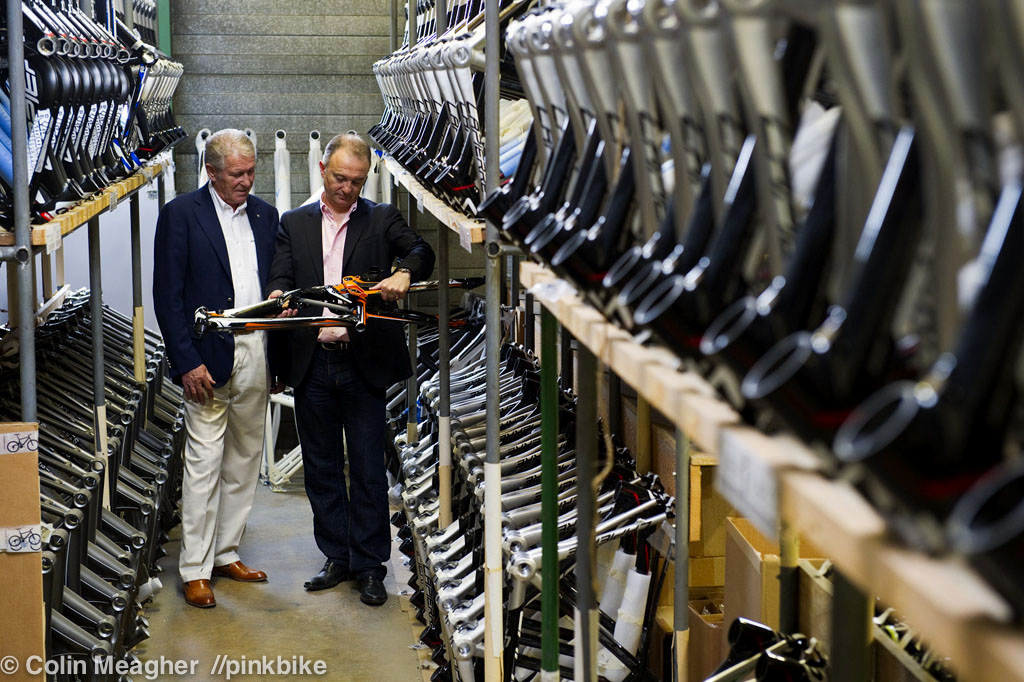Nov 10, 2021
by Seb Stott Follow

A lot of companies claim to care about the environment, but when I asked over forty bike brands if they have plans to measure and reduce their CO2 emissions, their responses were a mixed bag. I was glad to see some companies had put serious thought into this subject, though, and a few made big claims about cutting carbon and even going "carbon neutral" in the near future. But climate change is a complex topic and it's tough to distinguish genuine improvements from greenwashing.
Fortunately, Pinkbike's comments section can be an illuminating place. The top comment on that article was from professional sustainability consultant Mike Bascombe. He called out some brands for only discussing their direct emissions and ignoring their supply chains, where the vast majority of the CO2 is released. I messaged him directly to find out more and he agreed to answer some follow-up questions to help me see the wood from the carbon-offsetting trees - which brands have a credible plan to reduce their environmental impact, and which claims aren't as impressive as they sound?
 This moral reasoning doesn't need to exist at this stage. There is more than enough business-based justification. It's adapt or die for companies now.—Mike Bascombe
This moral reasoning doesn't need to exist at this stage. There is more than enough business-based justification. It's adapt or die for companies now.—Mike Bascombe First off can you tell us a bit about your background and your credentials?
First off can you tell us a bit about your background and your credentials?I work for a specialist sustainability consultancy called Avieco where my role focuses on strategies to reduce carbon emissions and helping clients adopt sustainable practices in the tech, culture, sport and media sectors. Bikes have always been a huge part of my life and my heart is firmly in the off-road community. To me, cycling holds answers for some of the biggest sustainability questions, but the industry needs an introspection that is emerging now. I am first and foremost an environmentalist and want cycling to be a force for preserving wilderness and appreciating it rather than contributing to its decline.
 How do you see the role of companies, as opposed to individuals or governments, in tackling climate change?
How do you see the role of companies, as opposed to individuals or governments, in tackling climate change?Companies play a vital role in mitigating climate change but the three groups are really interlinked. Businesses are reliant on an economy and market forces driven by customers (individuals) and regulation governments) so they can't be considered in isolation. There is clearly a move towards sustainability. Whilst there are some well-established brands that are known in this space (Patagonia for example) there is still room for pioneering brands to take a lead, especially within cycling.
Companies will soon be forced to adapt, the writing is on the wall. As the financial buying power moves to millennials and on to Gen Z sustainability becomes even more of a market force. These groups consider climate-related credentials as a key influence in which brands they are willing to spend and companies that don’t engage in sustainability will lose any connection with their customers. As disclosure projects like CDP are forced on companies by investors it becomes easier for anyone to rate a company on its climate credentials. Consumers won't buy a less sustainable option if there's a choice of equal value.
Sustainability is good business. Aligning your company to sustainable values makes you more attractive to both customers and investors at the same time as mitigating risks in your business model by addressing the threats to supply chains. Being aware of climate-related threats is in essence just awareness of resource availability. Awareness of the risks posed by climate change and mitigating them needs to be a core activity for any manufacturing business. The current supply issues the bike industry is experiencing due to COVID are small in comparison to the disruption that regular climate emergencies will cause.
Government regulation is backing up market forces by codifying the need to disclose through mechanisms like TCFD (Taskforce for Climate Related Disclosure) which forces companies to treat climate change as a financial threat and significant risk to business. Here in the UK, you cannot win a government contract over a certain size without having a Net Zero plan in place now, so business development is tied into sustainable practice. Companies that can't react to these evolving requirements simply won't get invested in, won’t win any work or will lose their customer base.
Look at Larry Fink at Blackrock, one of the biggest funds in the world, completely divesting from fossil fuel related investments purely from a risk perspective. Whilst I personally believe there is a moral imperative to do what you can to limit climate change on an individual and company level, this moral reasoning doesn't need to exist at this stage. There is more than enough business-based justification. It's adapt or die for companies now.
 Which brand(s) do you think gave the best response on their emissions targets or reporting?
Which brand(s) do you think gave the best response on their emissions targets or reporting?Looking at the responses in the article I have to applaud Trek here for producing a full sustainability report that included all 3 scopes (see below for more detail on these). Disclosing a footprint can be a painful process at the start. It shines a light on things that don't necessarily support sales or brand strength. Revealing that carbon frames are significantly worse from an emissions perspective than alloy versions is not something Trek's marketing team would want to highlight but the numbers are out in the open now. They have first-mover status and deserve the kudos for this.
What we will hopefully see now is the rest of the industry matching this ambition. Companies that don't report fully will soon be the outliers and the associated negative perception will kill the brands involved. The bar has been raised.
I think Cotic should be included too in their honesty and for clearly understanding the need for improvement. Decarbonising is not an easy thing. Companies will have to undergo massive transformation to reach the necessary levels but that all starts with an appreciation of the real status quo.
Ibis choosing to avoid air freight inbound is a huge deal and they have studied their supply chain in detail from a carbon perspective. They also have a healthy scepticism of offsets which is important.
Canyon are doing good work too. Aligning with the Science Based Targets initiative is really the best standard. It will be interesting to see which particular pathway they signed up for, however. So far there is just a commitment. I don't doubt their intentions but there is still a long process for them to get a real decarbonisation target approved and a pathway designed.
Both Endura and Pole have a focus on local manufacturing. This is a significant move and will greatly reduce the emissions overall because shipping is always such a large proportion. It also of course supports local industry and craftsmen.
 Were there any misleading claims, in particular, you'd like to call out?
Were there any misleading claims, in particular, you'd like to call out?Programs like GoGreen from DHL offer offsets equal to the carbon value of the shipping route. There are usually a number of issues with projects like these in the accuracy of carbon calculations and the quality of projects associated with them. Tree planting schemes don’t factor in several key issues which I discuss below. Even if the best projects are supported it doesn’t change the fact that offsetting without the company making any real decarbonisation themselves isn’t helping. Schemes like these can give companies a false sense of achievement in mitigating climate change, or can be manipulated to give the impression more is being done than reality would suggest. Offsetting has its place but only as a small part of a bigger change.
Any of the companies who report on only scope 1 and 2 whilst not mentioning 3 are choosing a very limited range of their operations to report on publicly. This won't include the majority of their footprint (more detail below) and could be considered misleading.
Similarly, any of the companies without a defined time frame are behind the curve. Without an endpoint, they can't have defined a yearly target to reduce emissions, which means they don't have a concrete reduction strategy. Lots of commitments and even "internal audit" but these ultimately mean very little.
 What do you think about bike companies buying offsets to reduce or neutralise their carbon emissions? Is that cheating, or a step in the right direction?
What do you think about bike companies buying offsets to reduce or neutralise their carbon emissions? Is that cheating, or a step in the right direction?Neutralisation of some emissions is inevitable. No company will realistically be able to completely decarbonise as that would negate manufacturing on any scale and make it unrealistic for companies to engage in change. The real question is at what point should offsetting, compensating or neutralisation happen.
The recent evolution of the Net Zero standard is a good example of considering this in real terms. Previously we had "carbon neutral". This is pretty meaningless in terms of actually reducing emissions or mitigating the climate crisis in a material way as a company could simply work out its emissions and buy offsets equal to that. No change in behaviour, no guarantee of offset quality or efficacy. Net Zero is far more stringent and forces companies to actually decarbonise to certain levels at certain time frames before neutralising or compensating.
The Science Based Target initiative has just released their definition for Net Zero which is great news as it standardized the process for companies and provides a roadmap. The other factor is the quality of the offset. There are good standards out there, The Gold Standard and VERRA for example, but many companies buy products that have little if no real benefit. Something people forget to include in many discussions are the time lags involved. Planting trees is an easy example as trees take time to mature to reach a certain level of CO2 absorption that is assumed by the offset calculation. The tree planting example also demonstrates how looking at an offset in isolation is rarely beneficial for the planet.
Old-growth forests are vital for biodiversity, soil health and are essentially irreplaceable, in any timeframe we're now working to, relating to global warming. Creating acres of fast-growing pines and claiming a similar positive effect purely looking at decarbonisation potential simply doesn't represent reality. If companies want to use neutralisation it needs to be thought out very thoroughly, ideally creating a bespoke project that the company can take ownership of throughout their decarbonisation journey.
There is unfortunately scope for offsetting to be abused. Some projects promise carbon sequestration based on misinterpreted or false data. The market is still not fully regulated so it is left to companies to find projects of real value and legitimacy. There are many people working in offsetting with a genuine desire to do good and there are projects offering real climate and social benefits but it is still too easy for some to take advantage.
As to whether offsetting can be a negative force in itself, that is certainly possible. If companies see it as purely a marketing tool, or if it in any way replaces actual decarbonisation then it is not part of the solution.
That being said there needs to be a recognition that companies are on a journey. Whole business models are needing to be reworked and global business realigned. Rapid decarbonisation is the priority and whilst this is underway there is a genuine case for compensating current operating emissions with good quality programs.
Similarly, once a company reaches the maximum decarbonisation it can (the current SBTi Net Zero standard puts this at a 90% reduction versus the baseline carbon emissions) the remaining operating emission should be neutralised. Offsets can not only serve to reduce carbon emissions but also support the United Nations Sustainable Development Goals (SDGs). These are aimed at supporting global social development and any company that claims to be based on any sort of social value should be using these as a framework. Good offsetting projects should support these goals at the same time, so it's not a straightforward carbon question. None of this is really. Climate change is inherently linked to global inequality, debt and racism. Companies who are leading in this space combine their environmental efforts with social ones too.
 If a company is serious about reducing their emissions, where should they start?
If a company is serious about reducing their emissions, where should they start?A deeply integrated footprint that covers all 3 scopes as defined by the Greenhouse Gas Reporting Protocol that is made publicly available. Many companies, especially in the manufacturing sector, only report on scopes 1 and 2. Scope 1 is direct emissions; company facilities and company cars. Scope 2 is electricity usage. Looking at these two only leaves out the vast majority of a company's emissions profile. Scope 3 has 15 categories and makes up the largest part of a carbon footprint for most companies. Scope 3 includes travel, purchased goods and services and critically for the bike industry transport and shipping among others. [According to Trek's sustainability report, shipping made up about 6% of their total emissions while bicycle manufacturing made up about 83%. Much of this could be counted under Scope 3 emissions.]
If any company is serious about making a positive change they will have to know where their hotspots are, where are the worst areas for emissions. Only a proper footprint can provide this. From there the company can strategise how best to change what they can within their own operations, and influence their value chain to reduce emissions. We are past the time for commitments now. Action is needed. You can't change what you don't know.












